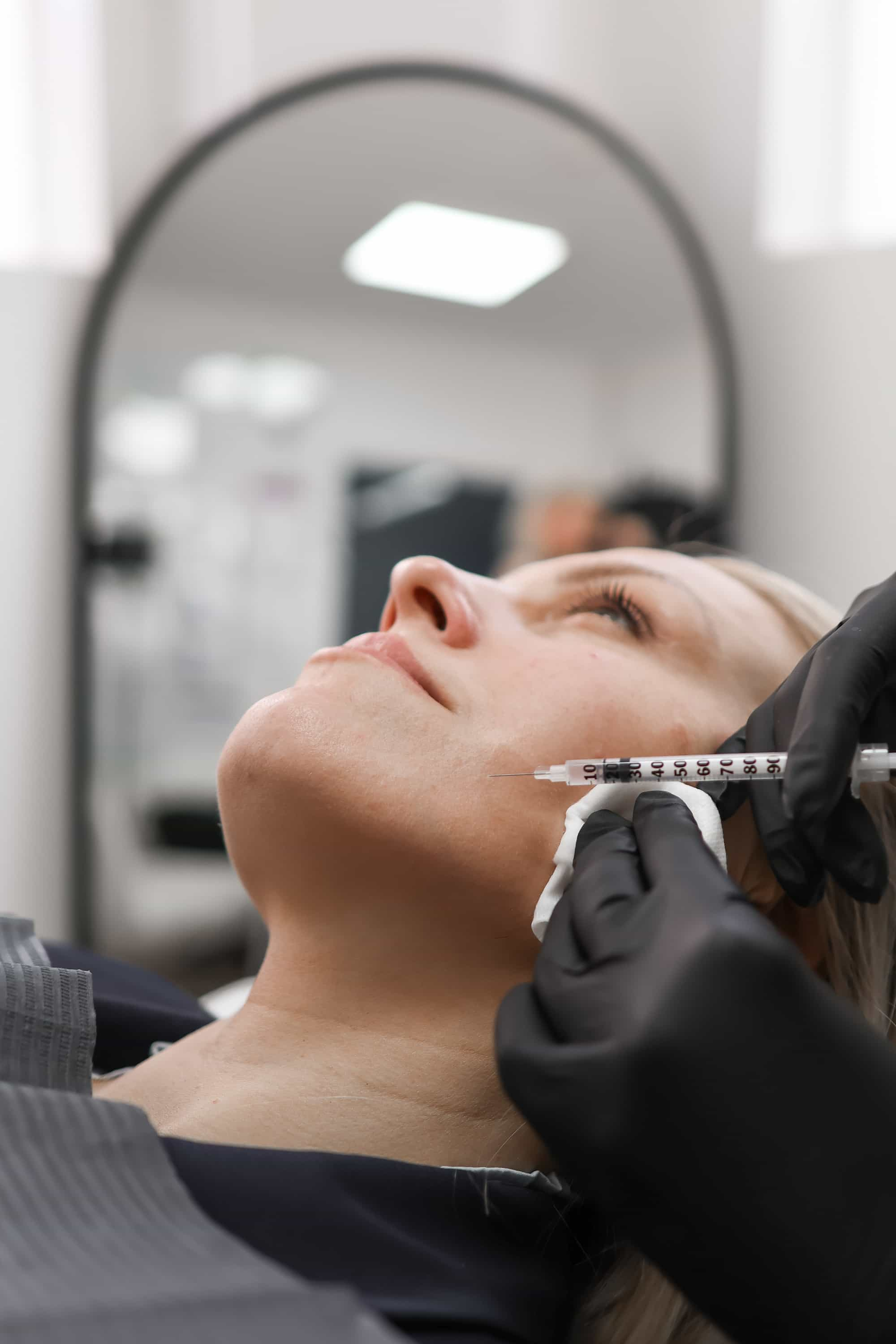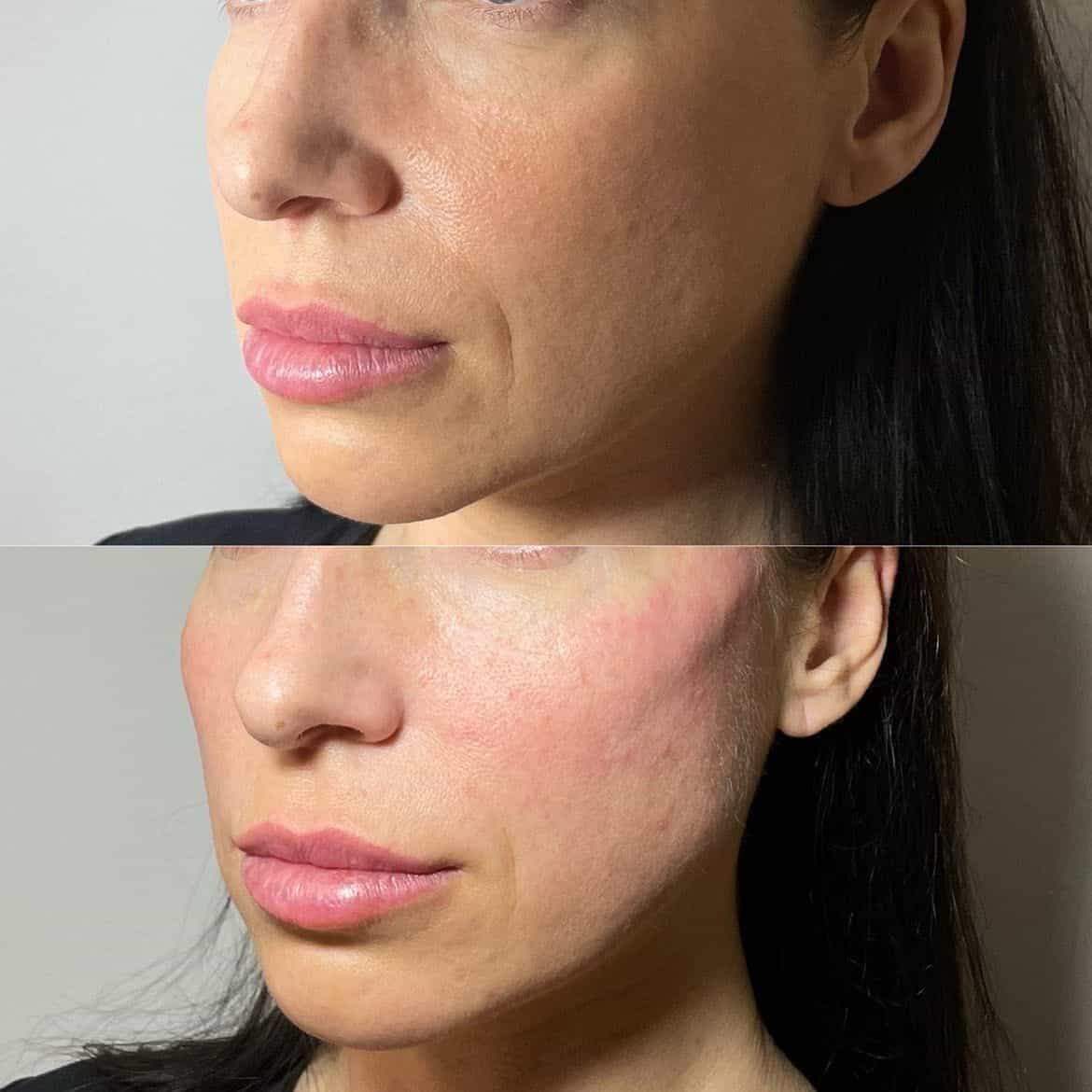Understanding Botox for Facial Lifting
A downturned smile can make you appear perpetually sad or melancholic, even when you feel happy. Thankfully, there are ways to lift those corners and reveal a brighter, more cheerful expression. Botox, a neurotoxin that temporarily paralyzes muscles, has become a popular non-surgical option for addressing facial asymmetry and achieving a subtly lifted smile.
What is Botox?
Botox is a purified form of botulinum toxin type A. It works by blocking the nerve signals that tell facial muscles to contract. When injected into specific muscles, Botox temporarily paralyzes them, reducing their ability to move. This can be used to smooth wrinkles caused by repetitive muscle movements, such as frown lines and crow’s feet.
In the context of a downturned smile, Botox injections are strategically placed into the muscles that pull the corners of your mouth downwards. By temporarily paralyzing these muscles, Botox allows the natural upward curve of your smile to become more prominent, resulting in a lifted and brighter appearance.
How Botox Works on Muscle Movement
Botox can be an effective way to lift a downturned smile by targeting specific facial muscles responsible for pulling down the corners of the mouth.
These muscles, known as the depressor anguli oris muscles, are often overactive in individuals with a downturned smile. By injecting Botox into these muscles, the nerve signals that cause them to contract are temporarily blocked. This leads to muscle paralysis, preventing them from pulling down the corners of the mouth.

As a result, the natural upward curve of the smile becomes more pronounced, creating a lifted and brighter appearance.
Areas Affected by Downturned Smiles
A downturned smile can make you appear perpetually sad or melancholic, even when you feel happy. Thankfully, there are ways to lift those corners and reveal a brighter, more cheerful expression. Botox, a neurotoxin that temporarily paralyzes muscles, has become a popular non-surgical option for addressing facial asymmetry and achieving a subtly lifted smile.
Botox is injected strategically into the muscles responsible for pulling down the corners of the mouth. These muscles, called the depressor anguli oris muscles, are often overactive in individuals with a downturned smile. By temporarily paralyzing these muscles, Botox allows the natural upward curve of your smile to become more prominent.
The result is a lifted and brighter appearance, effectively counteracting the downturn and revealing a more cheerful expression.
Consultation and Assessment
Before considering Botox injections to address a downturned smile, a thorough consultation and assessment are essential. This process involves a comprehensive evaluation of your facial structure, muscle movements, and desired outcome. During the consultation, your practitioner will discuss your concerns, medical history, and expectations. They will also examine your facial anatomy to determine the most appropriate injection points and dosage for achieving your desired results.
Determining the Cause of the Downturned Smile
A downturned smile can be a complex issue with various underlying causes. These can range from genetic factors influencing facial muscle structure to muscle imbalances developed over time due to habits like frowning or stress. Certain medical conditions, such as depression or Bell’s palsy, can also contribute to a downturned smile.
During the consultation and assessment phase, a qualified practitioner will meticulously analyze your unique situation to pinpoint the root cause of your downturned smile. This may involve detailed discussions about your medical history, lifestyle habits, and concerns. A physical examination focusing on facial muscle movements and symmetry will also be conducted.
Understanding the underlying cause is crucial for developing an effective treatment plan. Depending on the cause, a combination of approaches might be recommended, which could include Botox injections, facial exercises, or other non-surgical techniques.
Medical History and Lifestyle Factors
A downturned smile can make you appear perpetually sad or melancholic, even when you feel happy. Thankfully, there are ways to lift those corners and reveal a brighter, more cheerful expression. Botox, a neurotoxin that temporarily paralyzes muscles, has become a popular non-surgical option for addressing facial asymmetry and achieving a subtly lifted smile.
Consultation and assessment play a crucial role in determining whether Botox is the right treatment for you. During this process, a qualified practitioner will thoroughly evaluate your facial structure, muscle movements, and desired outcome. They will discuss your medical history, lifestyle factors, and expectations to understand your concerns and tailor a personalized treatment plan.
Your medical history provides valuable insights into potential contraindications or underlying conditions that might affect the treatment. Lifestyle factors such as stress levels, muscle tension habits, and any existing facial treatments can also influence the outcome of Botox injections. Understanding these aspects allows the practitioner to make informed decisions regarding injection points, dosage, and potential risks.
Treatment Planning
Consultation and assessment are essential steps in determining if Botox is an appropriate treatment for a downturned smile.
During this process, a qualified practitioner will thoroughly evaluate your facial structure, muscle movements, and desired outcome.
They will discuss your medical history, lifestyle factors, and expectations to understand your concerns and tailor a personalized treatment plan.
Your medical history provides valuable insights into potential contraindications or underlying conditions that might affect the treatment. Lifestyle factors such as stress levels, muscle tension habits, and any existing facial treatments can also influence the outcome of Botox injections.
Understanding these aspects allows the practitioner to make informed decisions regarding injection points, dosage, and potential risks.
Botox Injection Procedure
A downturned smile can make you appear perpetually sad or melancholic, even when you feel happy. Thankfully, there are ways to lift those corners and reveal a brighter, more cheerful expression. Botox, a neurotoxin that temporarily paralyzes muscles, has become a popular non-surgical option for addressing facial asymmetry and achieving a subtly lifted smile.
Preparation for Treatment
Before undergoing Botox injections, it’s important to prepare properly to ensure the best possible outcome. This preparation involves several steps that can help minimize potential risks and maximize the effectiveness of the treatment.
First, inform your practitioner about any medications you are currently taking, including over-the-counter drugs, vitamins, and herbal supplements. Certain medications may interact with Botox and potentially affect its effectiveness or increase the risk of side effects. It’s crucial to disclose all relevant medical information, including allergies, previous cosmetic procedures, and any history of bleeding disorders.
Next, avoid blood thinners such as aspirin or ibuprofen in the days leading up to your treatment. These medications can increase the risk of bruising or bleeding at the injection sites.
Additionally, refrain from consuming alcohol for at least 24 hours prior to the procedure, as alcohol can also contribute to bruising and may interfere with the Botox’s absorption.
On the day of your appointment, cleanse the area where injections will be administered gently with soap and water. Avoid using harsh cleansers or exfoliating products as they can irritate the skin and potentially increase the risk of complications.
The Botox Injection Process
Botox is a purified form of botulinum toxin type A. It works by blocking the nerve signals that tell facial muscles to contract. When injected into specific muscles, Botox temporarily paralyzes them, reducing their ability to move. This can be used to smooth wrinkles caused by repetitive muscle movements, such as frown lines and crow’s feet.
In the context of a downturned smile, Botox injections are strategically placed into the muscles that pull the corners of your mouth downwards. By temporarily paralyzing these muscles, Botox allows the natural upward curve of your smile to become more prominent, resulting in a lifted and brighter appearance.
Botox can be an effective way to lift a downturned smile by targeting specific facial muscles responsible for pulling down the corners of the mouth. These muscles, known as the depressor anguli oris muscles, are often overactive in individuals with a downturned smile. By injecting Botox into these muscles, the nerve signals that cause them to contract are temporarily blocked. This leads to muscle paralysis, preventing them from pulling down the corners of the mouth.
As a result, the natural upward curve of the smile becomes more pronounced, creating a lifted and brighter appearance.
Post-Treatment Care Instructions
Botox is a purified form of botulinum toxin type A. It works by blocking the nerve signals that tell facial muscles to contract. When injected into specific muscles, Botox temporarily paralyzes them, reducing their ability to move. This can be used to smooth wrinkles caused by repetitive muscle movements, such as frown lines and crow’s feet.
In the context of a downturned smile, Botox injections are strategically placed into the muscles that pull the corners of your mouth downwards. By temporarily paralyzing these muscles, Botox allows the natural upward curve of your smile to become more prominent, resulting in a lifted and brighter appearance.
Botox can be an effective way to lift a downturned smile by targeting specific facial muscles responsible for pulling down the corners of the mouth. These muscles, known as the depressor anguli oris muscles, are often overactive in individuals with a downturned smile. By injecting Botox into these muscles, the nerve signals that cause them to contract are temporarily blocked. This leads to muscle paralysis, preventing them from pulling down the corners of the mouth.
As a result, the natural upward curve of the smile becomes more pronounced, creating a lifted and brighter appearance.
Before undergoing Botox injections, it’s important to prepare properly to ensure the best possible outcome. This preparation involves several steps that can help minimize potential risks and maximize the effectiveness of the treatment.
- Inform your practitioner about any medications you are currently taking, including over-the-counter drugs, vitamins, and herbal supplements. Certain medications may interact with Botox and potentially affect its effectiveness or increase the risk of side effects. It’s crucial to disclose all relevant medical information, including allergies, previous cosmetic procedures, and any history of bleeding disorders.
- Avoid blood thinners such as aspirin or ibuprofen in the days leading up to your treatment. These medications can increase the risk of bruising or bleeding at the injection sites.
- Additionally, refrain from consuming alcohol for at least 24 hours prior to the procedure, as alcohol can also contribute to bruising and may interfere with the Botox’s absorption.
- On the day of your appointment, cleanse the area where injections will be administered gently with soap and water. Avoid using harsh cleansers or exfoliating products as they can irritate the skin and potentially increase the risk of complications.
Post-treatment care instructions are essential for maximizing the results of Botox injections and minimizing potential side effects. Following your practitioner’s guidelines will help ensure a smooth recovery and optimal outcome.
Here are some key post-treatment care instructions to follow after receiving Botox injections:
- Avoid touching or massaging the treated area for at least 24 hours. This helps prevent the spread of Botox and reduces the risk of bruising or swelling.
- Keep your head elevated while sleeping for the first few nights following the procedure. This can help minimize swelling and reduce the risk of Botox migrating to unintended areas.
- Apply cold compresses to the treated area if you experience any discomfort, redness, or swelling. Apply compresses for 15-20 minutes at a time, several times a day.
- Refrain from strenuous activities, including exercise and heavy lifting, for at least 24 hours after treatment. Strenuous activity can increase blood flow to the treated area and potentially spread Botox or cause bruising.
- Avoid exposure to extreme temperatures (hot baths, saunas, or direct sunlight) for at least a few days following treatment. Extreme temperatures can affect the absorption of Botox and may cause discomfort.
Results and Expectations
Results from Botox injections for a downturned smile typically become noticeable within 3 to 7 days after treatment, with full effects peaking around two weeks. The lifted effect usually lasts for 3 to 6 months, after which touch-up injections are needed to maintain the desired appearance. It’s important to note that individual results may vary depending on factors such as muscle strength, dosage, and metabolism.
It is crucial to have realistic expectations before undergoing Botox treatment. While it can effectively lift a downturned smile and enhance your facial expression, it cannot completely eliminate wrinkles or permanently alter your facial structure. The goal of Botox for this purpose is to subtly refine the appearance and create a more youthful and cheerful look.
Timeline for Visible Effects
Results from Botox injections for a downturned smile typically become noticeable within 3 to 7 days after treatment, with full effects peaking around two weeks. The lifted effect usually lasts for 3 to 6 months, after which touch-up injections are needed to maintain the desired appearance.
It is crucial to have realistic expectations before undergoing Botox treatment. While it can effectively lift a downturned smile and enhance your facial expression, it cannot completely eliminate wrinkles or permanently alter your facial structure. The goal of Botox for this purpose is to subtly refine the appearance and create a more youthful and cheerful look.
Long-Term Benefits
Results from Botox injections for a downturned smile typically become noticeable within 3 to 7 days after treatment, with full effects peaking around two weeks. This lifted effect usually lasts for 3 to 6 months, after which touch-up injections are needed to maintain the desired appearance.
The long-term benefits of Botox for a downturned smile include a more youthful and cheerful appearance. By subtly lifting the corners of your mouth, Botox can create a brighter and more approachable expression, boosting confidence and potentially impacting social interactions positively.
Potential Side Effects
Results from Botox injections for a downturned smile typically become noticeable within 3 to 7 days after treatment, with full effects peaking around two weeks. The lifted effect usually lasts for 3 to 6 months, after which touch-up injections are needed to maintain the desired appearance.
It is crucial to have realistic expectations before undergoing Botox treatment. While it can effectively lift a downturned smile and enhance your facial expression, it cannot completely eliminate wrinkles or permanently alter your facial structure. The goal of Botox for this purpose is to subtly refine the appearance and create a more youthful and cheerful look.
Potential side effects of Botox injections are generally mild and temporary. Common side effects may include bruising, swelling, redness, pain or tenderness at the injection site, headache, drooping eyelid, or eyebrow asymmetry. These side effects typically resolve within a few days to a week.
In rare cases, more serious side effects can occur, such as muscle weakness, difficulty swallowing, or breathing problems. It’s essential to seek immediate medical attention if you experience any severe or concerning side effects following Botox injections.
Maintaining the Lift
A downturned smile can make you appear perpetually sad or melancholic, even when you feel happy. Thankfully, there are ways to lift those corners and reveal a brighter, more cheerful expression. Botox, a neurotoxin that temporarily paralyzes muscles, has become a popular non-surgical option for addressing facial asymmetry and achieving a subtly lifted smile.
This article will delve into how Botox can be used to effectively lift a downturned smile, exploring the process, benefits, and considerations involved.
Follow-up Treatments
Botox injections are strategically placed into the muscles responsible for pulling down the corners of your mouth, called the depressor anguli oris muscles. These muscles are often overactive in individuals with a downturned smile. By temporarily paralyzing these muscles, Botox allows the natural upward curve of the smile to become more prominent, resulting in a lifted and brighter appearance.
Results typically become noticeable within 3 to 7 days after treatment, with full effects peaking around two weeks. The lifted effect usually lasts for 3 to 6 months, after which touch-up injections are needed to maintain the desired appearance.
Follow-up treatments are essential for maintaining the results of Botox injections. Since Botox is a temporary solution that gradually wears off over time, repeat injections are necessary to sustain the lifted smile. Typically, touch-up appointments are scheduled every 3 to 6 months, depending on individual factors such as metabolism and muscle activity.
During follow-up appointments, your practitioner will assess the effectiveness of the previous treatment and determine the appropriate dosage and injection points for maintaining the desired results. They may also adjust the treatment plan based on any changes in your facial structure or lifestyle habits.

Lifestyle Tips for Supporting Results
Maintaining a lifted smile after Botox injections involves following post-treatment care instructions, attending regular follow-up appointments, and adopting a healthy lifestyle.
Here’s how to help maintain your results:
* **Post-Treatment Care:** Continue to avoid touching or massaging the treated area for at least 24 hours. Keep your head elevated while sleeping for several nights after treatment. Apply cold compresses if needed, and avoid strenuous activities and extreme temperatures for a few days.
* **Follow-Up Appointments:** Touch-up appointments are essential for maintaining the lifted effect. These appointments typically occur every 3 to 6 months, allowing your practitioner to assess the results and adjust the dosage or injection points as needed.
* **Healthy Lifestyle:** A healthy lifestyle can contribute to long-lasting results:
* **Skincare:** A consistent skincare routine with moisturizers and sun protection helps maintain skin elasticity and minimizes the appearance of fine lines.
* **Hydration:** Drinking plenty of water keeps your skin hydrated and plump, aiding in wrinkle reduction.
* **Exercise:** Regular exercise improves blood circulation, which can benefit facial muscles and skin tone. Avoid strenuous activities immediately after treatment.
* **Diet:** A balanced diet rich in antioxidants and vitamins supports overall health, including skin health.
Remember, Botox is a temporary solution, and touch-up treatments are necessary to maintain the desired results.
Achieve your dream smile with Dr. Laura Geige at It’s Me & You Clinic.
- The Emotional Impact Of Cheating: Physical Vs Emotional Infidelity - June 2, 2025
- Natural-Looking Lip Fillers: Tips And Tricks For UK Clients - June 1, 2025
- What Are The Best CBD Infused Gummies For Overall Wellness - May 31, 2025
